The Effect of Space Weather on Cosmic Rays

(From left to right) Maccoy Merrell, Levi Villarreal, and Jacob Jeter. Not pictured: Marley Jeske
My senior year at Waxahachie Global High School, my schedule had 6 classes, which was the minimum needed by a senior at the time. However, rather than take an extra off period for the year, I decided that my time would be better spent as a teachers aid for my physics/chemistry teacher whose class I was taking for the third time.
However, being a teachers aid for Mrs. Restivo did not simply mean completing administrative tasks and filing paperwork. It included being an officer in the science club, entering research competitions, and conducting a 6 month long research project with the help of three of my fellow classmates, Jacob Jeter, Maccoy Merrell, and Marley Jeske.
This project taught me the joy that comes with conducting research, as well as the frustration and problems that go hand in hand with that joy. This project could have never happened without the 3 classmates that I listed above, SMU, FermiLab, the Quarknet program, the NOAA, and especially Mrs. Restivo, who piqued our interest with the Cosmic Ray Muon Detector.
Overview

Graphical representation of a cosmic ray hitting the atmosphere, resulting in a shower of muons
Cosmic rays have been studied by physicists for decades, but despite the common occurrence of the phenomenon, many aspects remain a mystery. However, studies from around the world have provided basic facts for these high energy particles. Different classifications of cosmic rays include galactic cosmic rays, anomalous cosmic rays, and solar energetic particles. Roughly 90% of primary cosmic rays that strike the Earth’s atmosphere are protons from hydrogen atoms, 9% are alpha particles, and the other 1% are made from heavier elements such as lithium.
Cosmic rays bombard the Earth at a rate of roughly 10,000 rays per meter per second. When high energy cosmic rays impact atomic nuclei in the atmosphere, pions are created, which quickly decay to their preferred state, muons. These muons shower down from the atmosphere to the surface of the Earth, and are able to be detected by scientific instruments. In fact, if you hold your hand out in front of you, roughly 2 cosmic rays will pass through it each second.
Purpose
Cosmic rays have long been a mystery in the scientific world. Our study will seek to further human understanding of these highly energetic particles, and the impact they have on the Earth. Our hypotheses focused on our data’s relation with the Sun’s orientation in the sky, as well as the solar cycle. We predicted that muon flux would increase during the day, and decrease during the night. This was based on research about the magnetosphere, and its relationship with solar winds.
Methods and Materials

The main components of the CRMD, disassembled
All of our experimentation and analysis was done through the use of a cosmic ray muon detector (CRMD) in conjunction with a computer. The counters were the most crucial piece of the CRMD assembly, as they were the piece of equipment that detected the muons as they showered down on the Earth.
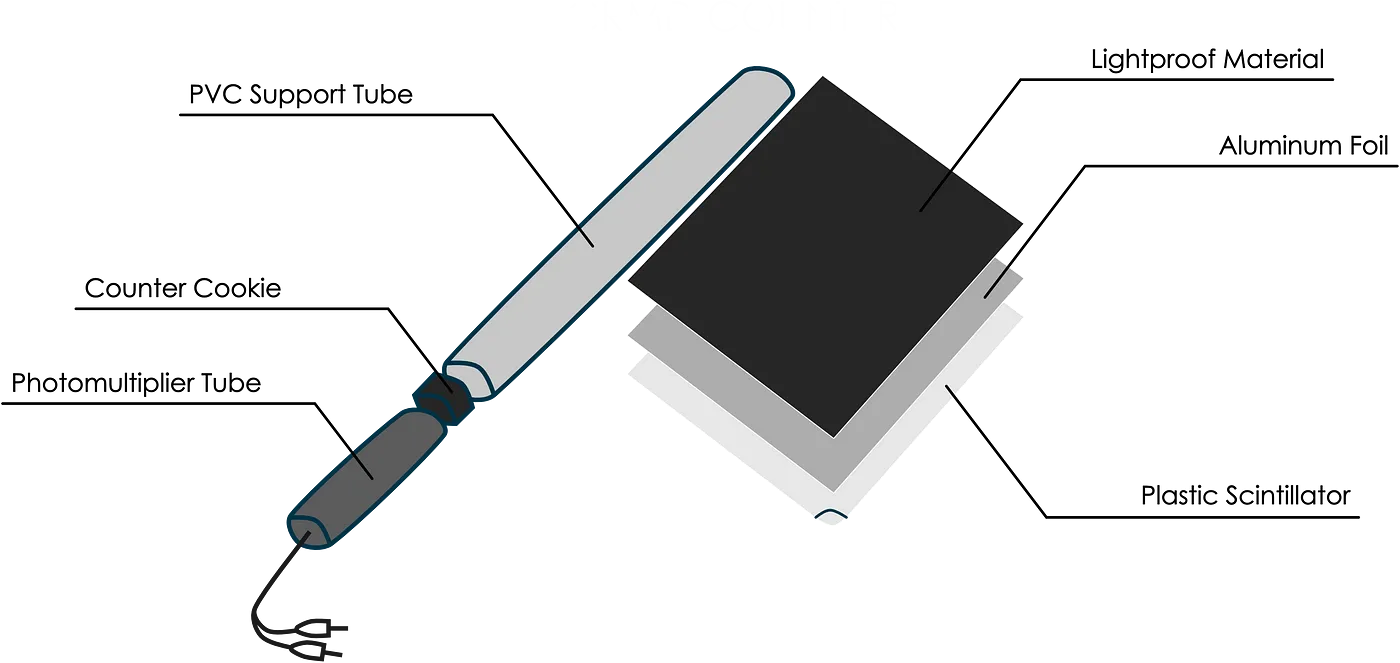
Graphical diagram of a CRMD Counter
Once the CRMD was assembled and calibrated within the correct parameters, it continually collected accurate data. Using the Cosmic Ray e-Lab User Interface, the data was captured and stored in text files. After data was collected for at least 5 days, the text files were uploaded to the Cosmic Ray e-Lab website to be blessed (verified) and analyzed.
The flux study research tool allowed the raw text data to be converted into graphs that showed how the muon count changed over time. Comparing these graphs to those of space weather allowed us to see trends and similarities that emerged. These similarities and the research that followed became the basis for our project.
Results
Muon Flux:
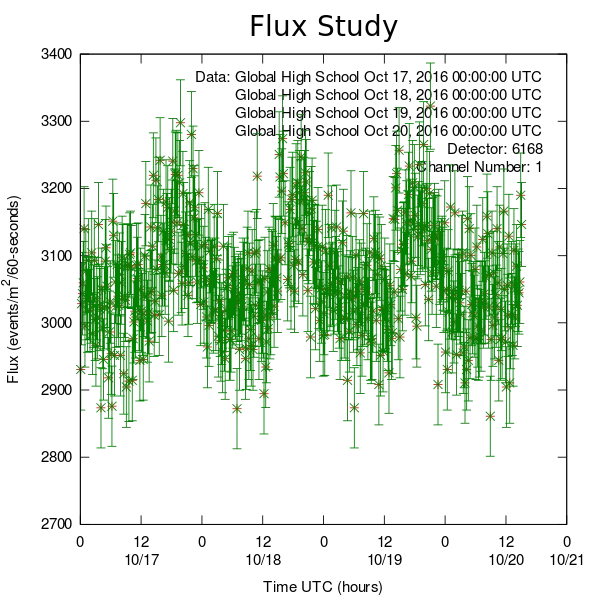
Muon flux studies were completed using data collected by our Cosmic Ray Muon Detector.
Muon and Electron Flux:
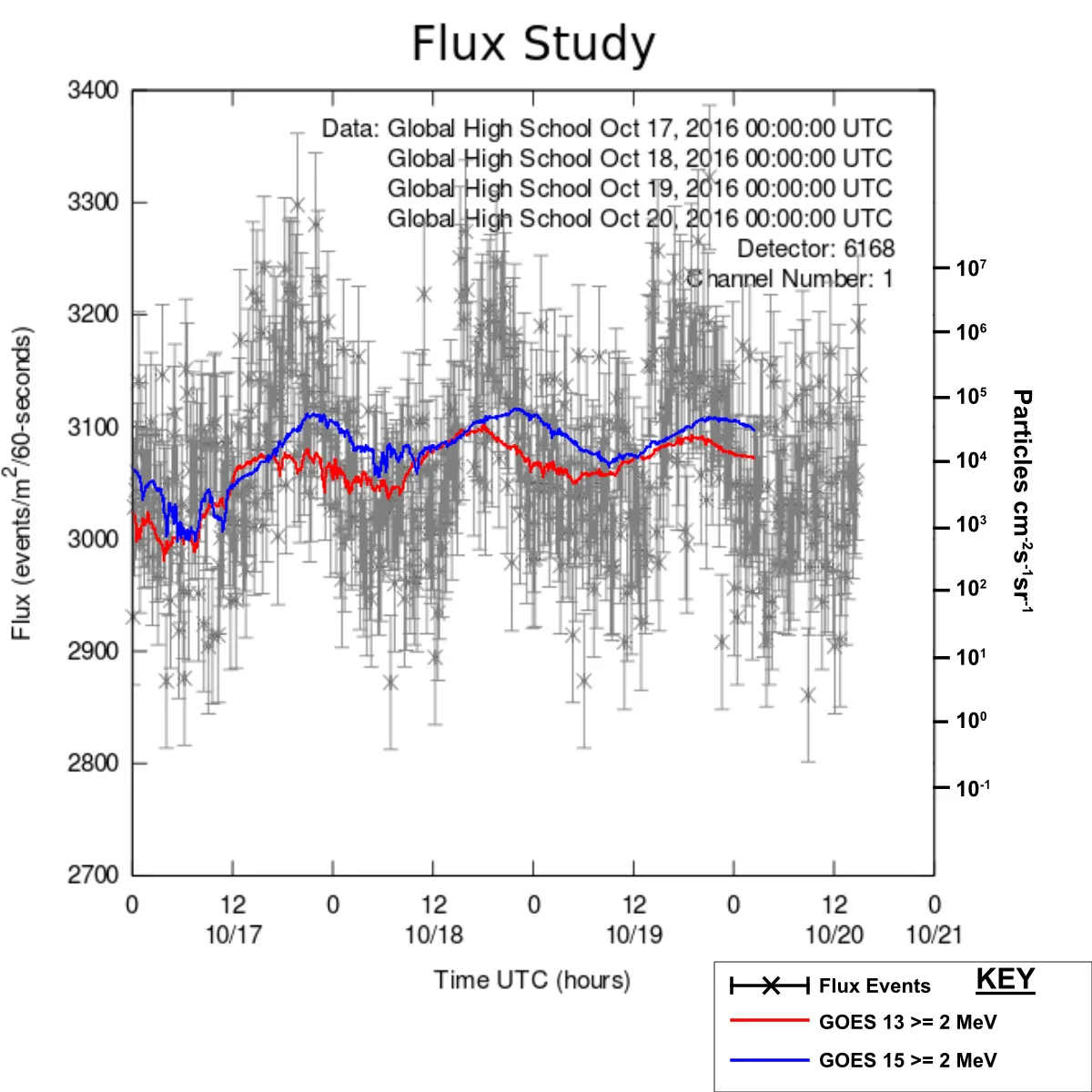
This graph shows the positive correlation that emerges when muon flux is overlaid with electron flux data from the GOES 13 and 15 satellites.
Muon Flux and Magnetometer:
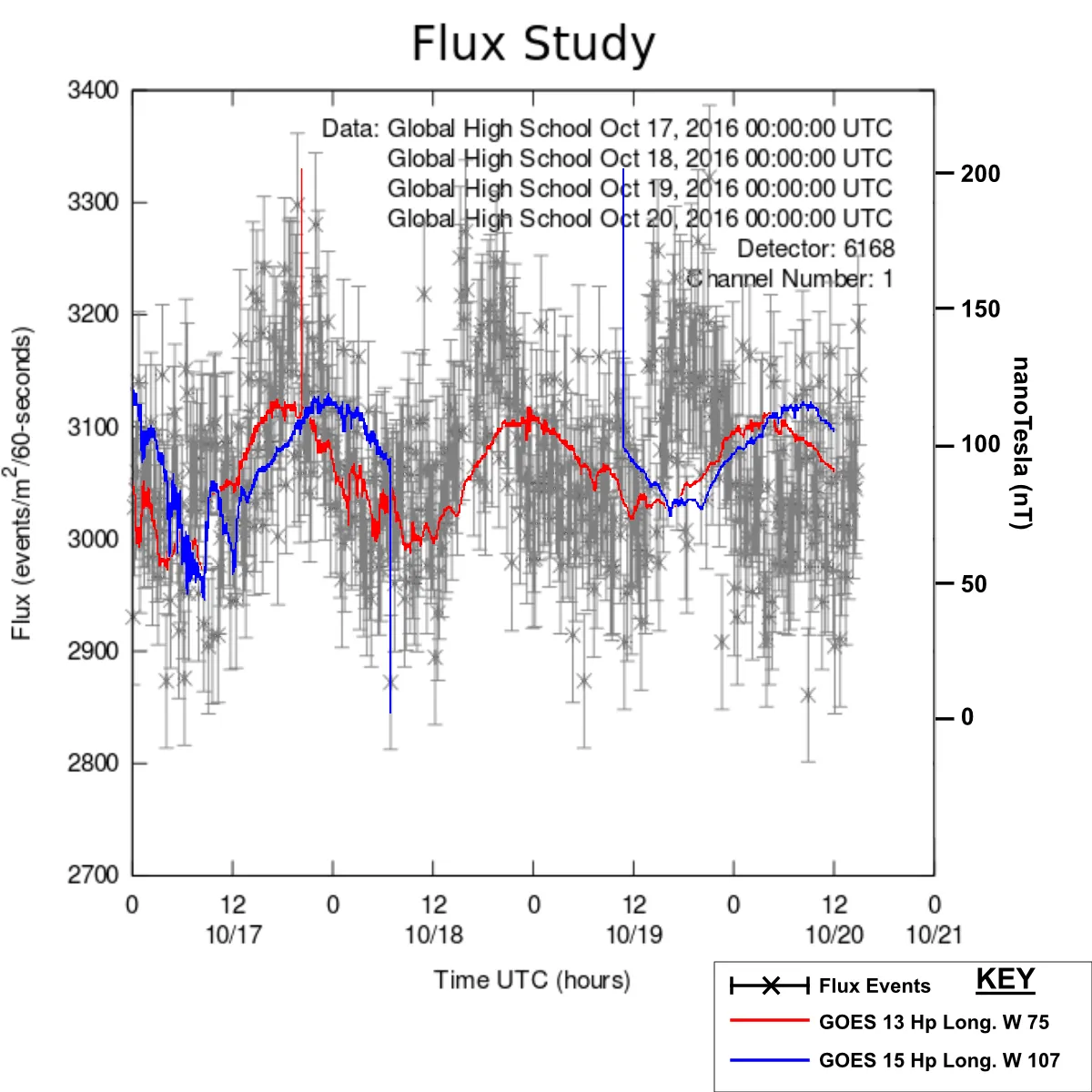
This graph shows the positive correlation that emerges when muon flux is overlaid with magnetometer data from the GOES 13 and 15 satellites.
This fluctuation allows us to study exactly how much of an increase the solar emission particles contribute to muon flux. Our data takes the form of a sine wave, typically fluctuating within a range of 200 events in a 24-hour cycle, with the peak of the sine wave correlating with local zenith, which is 6 hours behind UTC. During the months in which we recorded muon flux, we had a wide variety in the values of hits at the peak and trough, though the range of data was always approximately the same. At midnight local time we can assume that the only muon flux data we are receiving is entirely a result of galactic cosmic rays. Because of the correlation of galactic cosmic rays and magnetometer, we can use the graph of magnetometer provided by NOAA to find the data of galactic rays alone, without solar emission particles.
Using this process, the number of galactic protons can be represented by:
y = -50*cos(2πx) + 4450

Graph for the sine function
From this, at the noon peak of an average day, we receive a value of approximately 4500 muons from galactic sources, leaving roughly 100 muons not coming from galactic sources.
Discussion

Graph showing the origin of cosmic ray muons
Based on our calculations, the data shows that on a day with favorable circumstances, cosmic rays passing through a given region at noon will be comprised of 97.8% galactic cosmic rays, and 2.2% solar emission particles. However, the percentage of solar emission particles will decrease as the sun goes down, until it reaches or closely approaches zero.
This phenomenon can be explained by the Earth’s rotation as well as the magnetic field. As the earth revolves, the magnetosphere strengthens and our location approaches perpendicularity with the Sun. Because the Van Allen Belts are part of the magnetosphere, they also get stronger. This allows for more electrons to be captured in the belt from cosmic rays headed toward the Earth. This increased number of electrons in the Van Allen Belt produces the electron flux observed by the NOAA GOES satellites. The stripping of the electron as the particle passes through the Van Allen Belt means that these protons contain additional energy and thus have a higher chance of producing pions when colliding with ions in the upper atmosphere. It is these pions that decay into the muons that we record.
Furthermore, the chart also shows a sharp increase around noon local time. This is due to the solar emission particles emitted by the Sun during the day. However, during the night our position on Earth is facing away from the Sun, meaning that little to no solar emission particles will reach the cosmic ray muon detector under normal circumstances.
Future Implications
This data can bring a greater understanding as to where the cosmic rays observed on Earth are coming from, and what they mean to the billions of people living here. A possible implication of this data could be in space weather storms. Solar energetic particles have long been a major component in space weather storms and can cause problems with technology both in and around the Earth. These particles can penetrate satellites and cause failure, which is catastrophic for instruments that rely upon such technology. In addition, solar energetic particles can block radio communications at high altitudes, sometimes jamming the signal of a pilot’s radio. However, with data explaining exactly how much of the muons received on Earth are a result of solar emission particles, one can study the trends in data to predict satellite failure in advance without requiring expensive solar satellites..
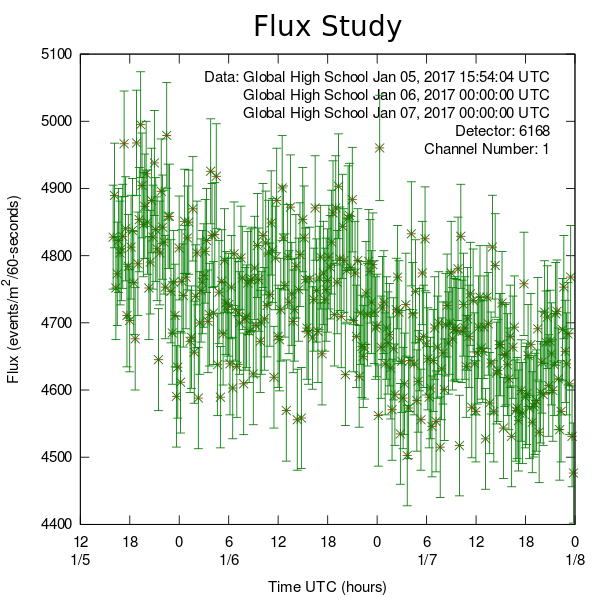
The Muon Flux graph during a solar storm in January of 2017
This muon flux study illustrates the relatively quick decrease that occurs as a solar storm subsides. This specific incident was a G1 (minor) geomagnetic storm in effect for the 4th and 5th of January 2017. By calculating the solar emission particle count before the storm, it may have been possible to predict it hours in advance.
Implications/Feedback of this Study
After we had put together our findings and finished our study, we decided to enter in the Dallas Regional Science and Engineering Fair (DRSEF). This is one of the largest regional science fairs in the country, and had hundreds of projects in diverse categories relating to science and engineering. We were the only team to enter in our entire county, and were the first in years to take part in the competition.
Our project was put in the physics and astronomy category of the competition, and was judged by about ten physics professors, industry professionals, and other volunteer judges of the competition over the course of two hours. As a result of this competition, we were awarded an honorable mention from DRSEF, an special award for Outstanding Achievement in Atmospheric Science from the American Meteorology Society, as well as an additional honorable mention from American Meteorology Society North Texas Chapter.
The special award we received gained us an invite to the DRSEF awards banquet held on campus at Southern Methodist University, where we received our award along with all of the others science fair winners.
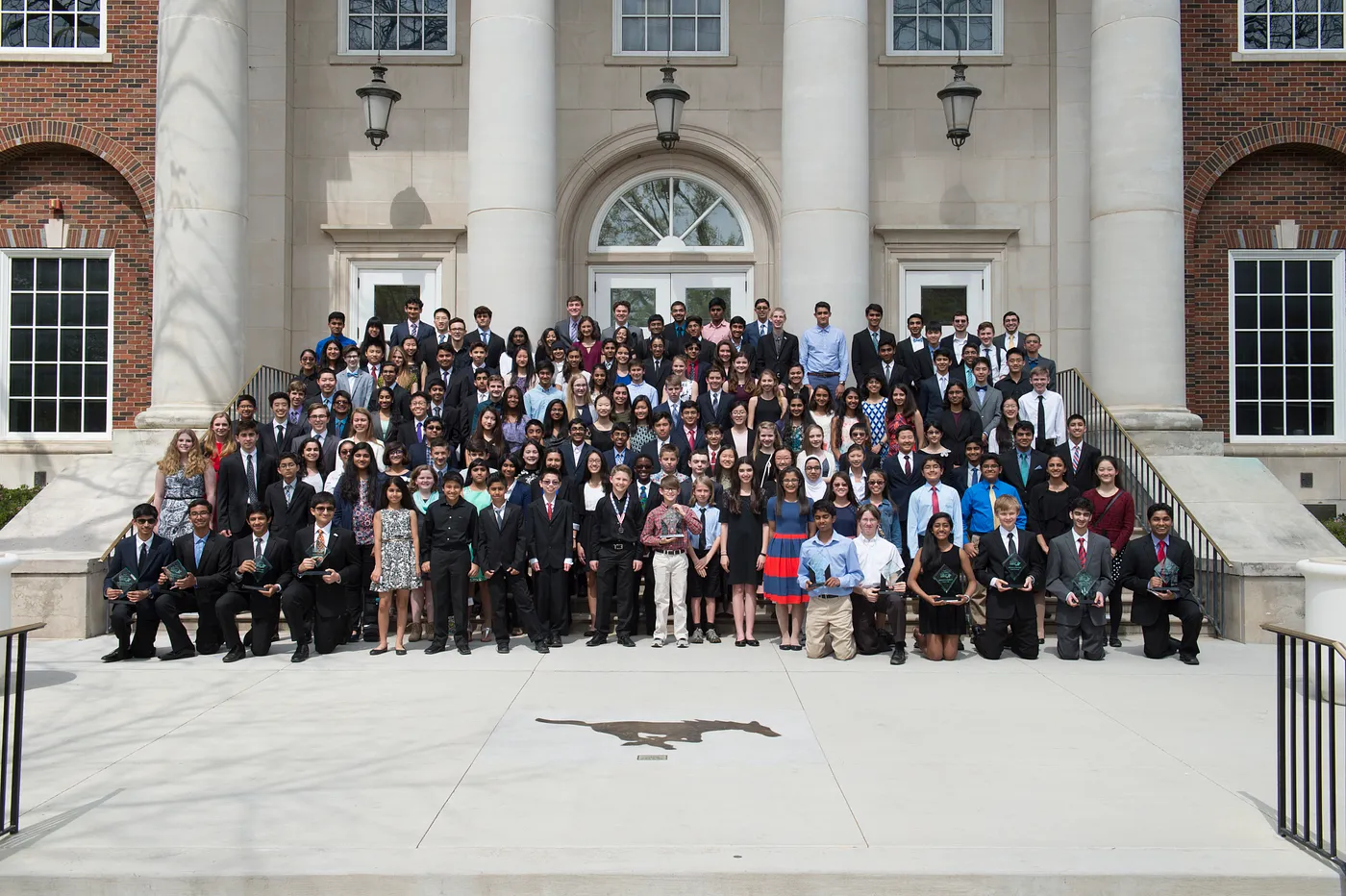
The winners of the 2017 DRSEF
Furthermore, because of our efforts and research regarding cosmic ray muons, we were nominated for and received the 2017 Physics Student of the year award from the American Physics Teachers Society. This award was presented to us by our teacher and project mentor, Mrs. Restivo on the annual Waxahachie Global awards night.
In addition, because we were the only science fair team in our area to compete, the Waxahachie Daily Light, wrote a story about our project that was printed in the local paper. However, the story is full of misquotes and factual errors, so not everything in it is 100% correct.
Conclusion
As I have said many times to my family, friends (and strangers!), science fair was the best thing that I did in my high school career. It opened me up to the world of academic research and allowed me to work closely with my peers to come up with a result that had never before been studied. The work was tough but rewarding, and worth every all-nighter that we pulled in the weeks leading up to the science fair. I hope that our project one day benefits another researcher, and inspires others at our alma mater to conduct their own research and compete in future science fairs.
To read the full results of this study, please read the full research paper with sources here